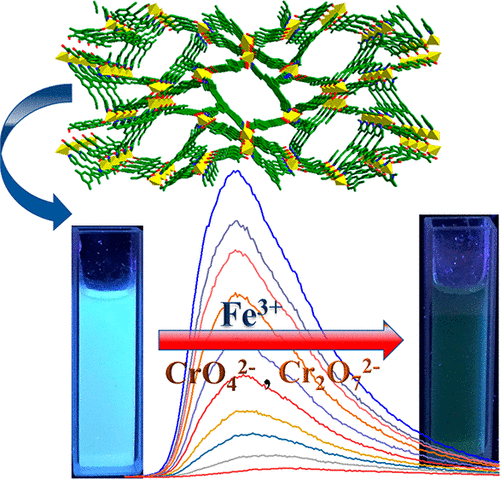当前位置:
X-MOL 学术
›
Inorg. Chem.
›
论文详情
Our official English website, www.x-mol.net, welcomes your
feedback! (Note: you will need to create a separate account there.)
Water Stable Zn(II) Metal-Organic Framework as a Selective and Sensitive Luminescent Probe for Fe(III) and Chromate Ions.
Inorganic Chemistry ( IF 4.3 ) Pub Date : 2020-06-05 , DOI: 10.1021/acs.inorgchem.0c00545 Bibhuti Bhusan Rath 1 , Jagadese J Vittal 1
Inorganic Chemistry ( IF 4.3 ) Pub Date : 2020-06-05 , DOI: 10.1021/acs.inorgchem.0c00545 Bibhuti Bhusan Rath 1 , Jagadese J Vittal 1
Affiliation

|
Sensing and monitoring toxic contaminants like Fe3+, CrO42–, and Cr2O72– ions in water is very important due to their harmful effects on biological and environmental systems. Enhanced hydrolytic stability, sensitivity, and selectivity, in addition to their excellent luminescence properties, are important attributes of metal–organic framework (MOF)-based sensors for sensing applications. In this work, the water stable Zn–MOF [Zn2(tpeb)(bpdc)2] (where tpeb = 1,3,5-tri-4-pyridyl-1,2-ethenylbenzene and bpdc = biphenyl-4,4′-dicarboxylic acid) was synthesized and characterized. The framework retains its crystallinity and structural integrity in harsh acidic and basic conditions (pH 4–11). Most interestingly, the Zn–MOF demonstrates a strong blue luminescence in water that can be quenched selectively only by contaminants like Fe3+, CrO42–, and Cr2O72– ions. Higher Ksv values and low detection limits in selective luminescence quenching confirm the superior sensing performance, which is comparable to those of contemporary materials. Furthermore, in all cases, quenching efficiency remains unaltered in the presence of interfering ions, even after the compound is used in multiple cycles, which makes this MOF an attractive, reliable, and recyclable luminescent sensor material. The luminescence quenching mechanism is based on the competitive absorption and weak interactions. It is worth noting that most of the reported MOF-based sensors used for the separate sensing of Fe(III) and chromate ions are used in organic media due to their poor hydrolytic stabilities. Reports on the dual sensing of Fe(III) and chromate ions, which are also in aqueous media, are rare. Based on these results, Zn–MOF can be considered as a suitable candidate for advanced practical applications for the efficient sensing of Fe(III) and chromate ions in water.
中文翻译:

水稳定的Zn(II)金属有机骨架,作为Fe(III)和铬酸根离子的选择性和灵敏发光探针。
感知和监测水中的Fe 3+,CrO 4 2–和Cr 2 O 7 2–离子等有毒污染物非常重要,因为它们会对生物和环境系统产生有害影响。除具有出色的发光特性外,增强的水解稳定性,灵敏度和选择性是用于传感应用的基于金属-有机框架(MOF)的传感器的重要属性。在这项工作中,水稳定的Zn–MOF [Zn 2(tpeb)(bpdc)2](其中tpeb = 1,3,5-三-4-吡啶基-1,2-乙烯基苯,并且bpdc =联苯-4,4'-二羧酸)并进行表征。该框架在苛刻的酸性和碱性条件(pH 4-11)下仍保持其结晶度和结构完整性。最有趣的是,Zn–MOF在水中表现出强烈的蓝色发光,只能被诸如Fe 3+,CrO 4 2–和Cr 2 O 7 2–离子之类的污染物选择性地淬灭。高K sv选择性发光猝灭的检测值和低检测限证实了优越的传感性能,可与当代材料相媲美。此外,在所有情况下,即使在多次使用化合物后,在存在干扰离子的情况下,淬灭效率也不会改变,这使该MOF成为有吸引力,可靠且可回收的发光传感器材料。发光猝灭机理基于竞争性吸收和弱相互作用。值得注意的是,大多数用于分离检测Fe(III)和铬酸根离子的基于MOF的传感器均因其较差的水解稳定性而用于有机介质中。关于Fe(III)和铬酸根离子(也存在于水性介质中)的双重检测的报道很少。根据这些结果,
更新日期:2020-07-06
中文翻译:

水稳定的Zn(II)金属有机骨架,作为Fe(III)和铬酸根离子的选择性和灵敏发光探针。
感知和监测水中的Fe 3+,CrO 4 2–和Cr 2 O 7 2–离子等有毒污染物非常重要,因为它们会对生物和环境系统产生有害影响。除具有出色的发光特性外,增强的水解稳定性,灵敏度和选择性是用于传感应用的基于金属-有机框架(MOF)的传感器的重要属性。在这项工作中,水稳定的Zn–MOF [Zn 2(tpeb)(bpdc)2](其中tpeb = 1,3,5-三-4-吡啶基-1,2-乙烯基苯,并且bpdc =联苯-4,4'-二羧酸)并进行表征。该框架在苛刻的酸性和碱性条件(pH 4-11)下仍保持其结晶度和结构完整性。最有趣的是,Zn–MOF在水中表现出强烈的蓝色发光,只能被诸如Fe 3+,CrO 4 2–和Cr 2 O 7 2–离子之类的污染物选择性地淬灭。高K sv选择性发光猝灭的检测值和低检测限证实了优越的传感性能,可与当代材料相媲美。此外,在所有情况下,即使在多次使用化合物后,在存在干扰离子的情况下,淬灭效率也不会改变,这使该MOF成为有吸引力,可靠且可回收的发光传感器材料。发光猝灭机理基于竞争性吸收和弱相互作用。值得注意的是,大多数用于分离检测Fe(III)和铬酸根离子的基于MOF的传感器均因其较差的水解稳定性而用于有机介质中。关于Fe(III)和铬酸根离子(也存在于水性介质中)的双重检测的报道很少。根据这些结果,











































 京公网安备 11010802027423号
京公网安备 11010802027423号